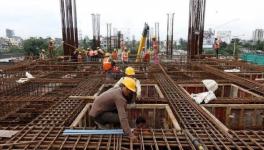Budget for Rural Development – Does it Meet Expectations?
Representational use only.
The COVID-19 pandemic and consequent regulations continue to impact employment and livelihoods. As a result of reverse migration, which started after the first lockdown was announced in March 2020, millions of workers (primarily engaged in urban informal sectors) returned to rural areas that added surplus labour to the already burdened rural economy. The rural sector is still facing unemployment, income decline, and absolute poverty increase. To address this situation, additional expenditure by the government was urgently required for compensating the losses sustained due to COVID-19 and subsequent lockdowns during 2020-21 and 2021-22, and to bolster the rural sector to revive the overall economy.
The share of the Department of Rural Development increased from 4.60% of the total Union Budget in 2019-20 to 5.63% in 2020-21. The increase was expected to continue for the much-needed bolstering of the rural sector, but the revised estimates (RE) of 2021-22 saw it drop. It has come down further and is at 3.50% in this budget. Expenditure should have increased to reduce the rural distress, but the trend does not support this expectation. The Department’s expenditure has also declined as a proportion to Gross Domestic Product (GDP). In the BE of 2022-23 it stood at 0.54%, which is the lowest since 2019-20.
NEED FOR SUSTAINED REVIVAL OF RURAL EMPLOYMENT
Mahatma Gandhi National Rural Employment Guarantee Scheme (MGNREGS), a demand-driven programme, guarantees at least one hundred days of wage employment to unskilled rural labourers. During 2020-21, out of 13.32 crore people who applied for work under the scheme, 13.29 crores were given work. In 2021-22, till the first week of January, 11.30 crore people had applied for work, of which 11.22 crore were given work. Given the trend in demand for work under the scheme, by the end of this fiscal year, there will be an addition in the number of people who demand work. Allocation for the scheme remains the same as the previous fiscal, at Rs 73,000 crore. In 2021-22 FY, as the initial allocation got spent midway through the year, additional funds were provided through the supplementary budget, taking its budget to Rs 98,000 crore. The current allocation is lower by 25.5% than the RE of 2021-22, even though the grants made under the MGNREGS fall insufficient every year because of higher demand for work, pending liabilities of material and administrative components and wage arrears of unskilled workers. The pending liabilities of wage bills as of December 2021 was Rs. 3,655 crore. On the one hand, we are witnessing an all-time high demand for work under the MGNREGS, and on the other hand, there is a reduction in allocation.
A recent study by the Centre for Economic Data and Analysis, Ashoka University reveals that instead of guaranteed 100 days of work, an average of just 22 days’ employment (national average) was provided to registered households on a pan-India basis in 2020-21; whereas the government claims that an average of 51.52 days of work was provided under the scheme in 2020-21. This difference in the calculation of the number of days of work provided is due to methodological differences. The former calculation was made based on registered households under the MGNREGS. In contrast, the government's higher days of work claim is by taking into account only those families who obtained at least one day's employment as a base. This mismatch of demand and supply under the scheme also signifies that more resources under MGNREGS are needed to provide 100 days of work as guaranteed under the scheme.
Although wage rates were revised for MGNREGS work based on Consumer Price Index-Agricultural Labourers (CPI-AL) by the Central government following the scheme's provisions, still legal minimum wages for unskilled workers are found to be much higher than the wage rate under the MGNREGS. In most states, the legally prescribed minimum wages for unskilled workers were higher than MGNREGS wages, whereas, in 12 states, the legal minimum wages were 50-75% higher than the MGNREGS wages.
DISPROPORTIONATE BUDGETING FOR WOMEN IN MGNREGS
Of the total active workers under the MGNREGS, women workers' participation stood at 54.59% in 2018-19, 54.78% in 2019-20 and 53.07% in 2020-21. However, only 33% of the budget under MGNREGS is reported for women in Part B of Statement 13 of the Gender Budget. In the BE of 2022-23. The allocation for women under the MGNREGS is Rs 26,000 crore, whereas in the RE of 2021-22 it was Rs. 32,666.6 crore. Given women’s higher participation in MGNREGS work, the allocation reported in the gender budget statement needs to be increased.
ENHANCED EXPENDITURE ON RURAL CONNECTIVITY
The budget allocation for the Pradhan Mantri Gram Sadak Yojana (PMGSY) has gone up from Rs 14,000 crore in the RE of 2021-22 to Rs 19,000 crore in the BE of 2022-23, an increase of almost 35.7%. The expansion will undoubtedly boost rural connectivity and employment generation in rural areas. However, the PMGSY programme regularly witnesses work delays that hamper employment and income generation and rural connectivity.
A significant concern is the full utilisation of the funds available under the scheme. Many states could not utilise the PMGSY budget made available to them. Though the PMGSY is an ongoing programme, as of July 15, 2021, under PMGSY Phase I, around 12.25% of the allocation remained unspent; in phase II, 26.5% was unspent; and in phase III, 85.5% remained unspent. Regarding interstate variation in fund utilisation under the PMGSY among major states, Punjab was the only state which could utilise more than 80% of the allocation. In contrast, Andhra Pradesh, Assam, Bihar, Gujarat, Haryana, Jharkhand, Karnataka, Madhya Pradesh, Maharashtra, Odisha, Tamil Nadu, Uttar Pradesh and West Bengal utilised less than 60% of the funds allocated to them in the period from 2016-17 to 2021-22. The remaining major states could utilise 60% to 80% of the allocated funds.
RURAL HOUSING
In response to a Parliamentary Question, it was shared that a total of 2.95 crore pucca houses were targeted for construction in rural India by 2022 under the Pradhan Mantri Awas Yojana - Gramin. However, as of December 2, 2021, with just one year left to achieve this target, 1.65 crore houses have been completed. The estimated budget for 2022-23 under PMAY-G is Rs 20,000 crore, slightly lower than the RE of 2021-22. Some concerns about implementing this scheme include poor quality of construction and wrongful exclusion/ inclusion of beneficiaries. The audit reports had reported that the AwaasSoft portal shows completion of construction in some cases, but this was not the case on the ground when a physical inspection was carried out.
In the last two years, the rural economy has faced sudden labourers, employment and income losses. To revive the economy, there is a need to increase the fiscal space for these programmes. It will further employment and income that may induce the consumption and buying power of the rural population. The increased purchasing power will lead to more consumption of primary commodities and items manufactured by the medium and small scale industries resulting in higher employment and income generation. This can help in pursuing the path of economic recovery.
Santosh Verma and Anisha Anustupa work with the Centre for Budget and Governance Accountability. Their views are personal.
Get the latest reports & analysis with people's perspective on Protests, movements & deep analytical videos, discussions of the current affairs in your Telegram app. Subscribe to NewsClick's Telegram channel & get Real-Time updates on stories, as they get published on our website.
























